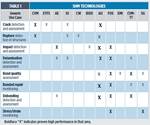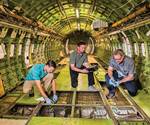Structural health monitoring: Decades of demos build confidence
Current momentum in local structural health monitoring development can be credited to a great deal of developmental effort on the part of these system developers.
Current momentum in local structural health monitoring (SHM) development can be credited, in part, to developmental effort on the part of the system developers that follow.
CVM system demonstrations in both metal and composites applications by Structural Monitoring Systems (SMS, Nedlands, Australia; Century City, CA, US and Ashford, UK) include installations flying on military fixed-wing aircraft and rotorcraft as well as commercial airliners in service, most notably for Delta Air Lines (see main article). The last readings from those systems — mounted to metal structures — were taken a couple of years ago, making that nearly a decade of in-flight service, and that data was subsequently shared with the US Federal Aviation Admin. (FAA, Washington, DC, US).
Brazilian aircraft manufacturer Embraer (Embraer-Empresa Brasileira de Aeronautica S.A., São José dos Campos) also has E-190 regional jet aircraft fitted with CVM and SMART Layer systems flying for several commercial airline customers, as it prepares to introduce a scheduled structural health monitoring (S-SHM) system that involves the installation of fatigue and corrosion sensors in hard-to-access areas of the aluminum airframe around the aft doors.
Meanwhile, Acellent Technologies (Sunnyvale, CA, US), the US Army Research Laboratory (ARL, Adelphi, MD) and the Aero-Flight Dynamics Directorate (AFDD, Moffett Field, CA, US) have been flight-testing Acellent’s SMART Layers on H-60 Blackhawk helicopter metal structures for 5 years to validate their integration and long-term operation and survivability on rotorcraft. Acellent also has completed Small Business Innovation Research (SBIR) projects with the US Navy for SHM systems on composites, which are supported by H-60 manufacturer, Sikorsky (Stratford, CT, US), for future implementation on the more composites-intensive CH-53K.
Other large-scale tests include those completed by the Tokyo, Japan-based “heavies” — Fuji Heavy Industries, Kawasaki Heavy Industries and Mitsubishi Heavy Industries — as part of the Japanese SHM Technologies for Aircraft Composite (JASTAC) structures program. In 2013, Airbus (Toulouse, France) extended this program to a second phase — which also includes the Japanese Aerospace Exploration Agency (JAXA, Tokyo) — targeted to deploy Phase I optical fiber-based SHM technologies into aircraft, extending through what Airbus terms Generation 3 in its SHM Roadmap (see the Roadmap in chart form, at left).
This short article is a sidebar to a feature story titled "Structural health monitoring: NDT-integrated aerostructures enter service," for which there is also a companion sidebar, titled "Structural health monitoring: The toolbox." To read either story, click on its title under "Editor's Picks," at top right.
Related Content
-
Composite prepreg tack testing
A recently standardized prepreg tack test method has been developed for use in material selection, quality control and adjusting cure process parameters for automated layup processes.
-
Materials & Processes: Tooling for composites
Composite parts are formed in molds, also known as tools. Tools can be made from virtually any material. The material type, shape and complexity depend upon the part and length of production run. Here's a short summary of the issues involved in electing and making tools.
-
Thermoset-thermoplastic joining, natural fibers enable sustainability-focused brake cover
Award-winning motorcycle brake disc cover showcases potential for KTM Technologies’ Conexus joining technology and flax fiber composites.
















